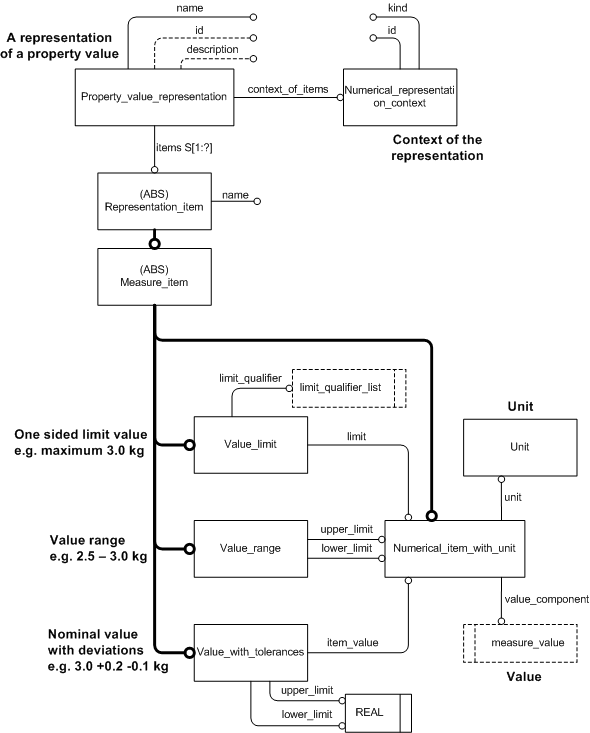
| Capability (C084):— representing_property_value_ranges | Date: 2007/06/22 12:22:11 Revision: 1.13 |
This section provides a business level overview of this capability.
Part specifications are composed of properties and their allowed values. Property values may be complex, such as vectors, tensors, or distributions, but for purposes of specification and measurement, they reduce to one or more simple numerical values, and an allowed value for each which is just a range of numbers. A part conforms to an aspect of a specification if the property value lies within the specified ranges.
PLCS provides the capability to specify a range of numbers in several ways:
EXAMPLE Mass = 5.0 +/- 0.5 kg.
This section provides an overview of the information model that supports this capability.
An EXPRESS-G diagram for the model used in representing property value ranges is shown in Figure 1 below.

NOTE Either limit may be positive or negative, and they may be the same or different.
The Property_value_representation is assigned to a property through the following entities:
Figure 2 shows the use of value limit to establish a property value that is 5.05 kg. or less. Only Value_limit is included in the list of items
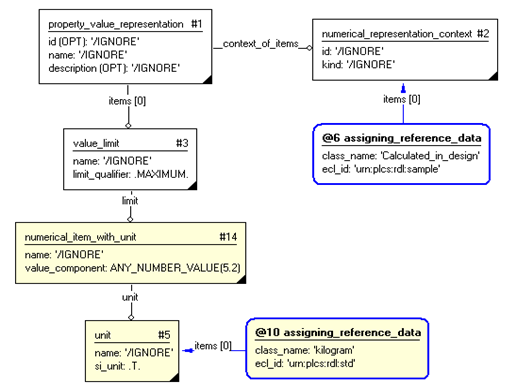
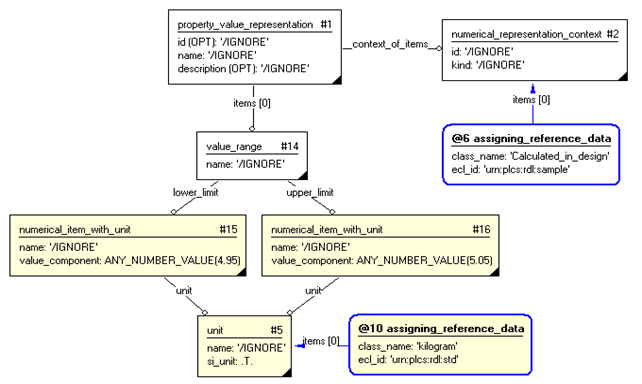
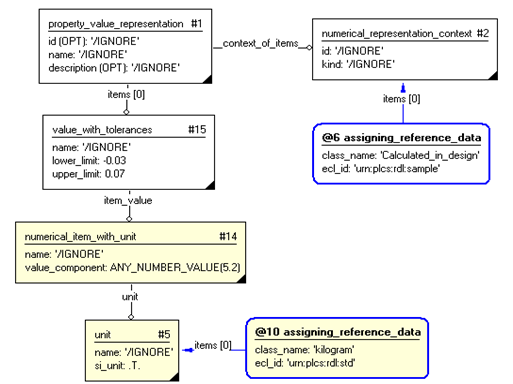
The use of external reference data for Units is described in Capability C096: representing_value_with_unit.
The following sections define a set of templates for the capability, where a template is a specification of a set of entities that need to be instantiated to represent a given set of information.
This section specifies the template representing_value_limit.
NOTE An explanation of a template and the associated instantiation path is provided in the Template overview section.
This template describes how to represent a value limit with associated unit for any property.
EXAMPLE The maximum weight (in kilograms) of an item.
NOTE The definition of the property itself (e.g. weight) and the item to which it may be assigned, are not in scope of this template. This template provides for the value limit and associated unit for the value.
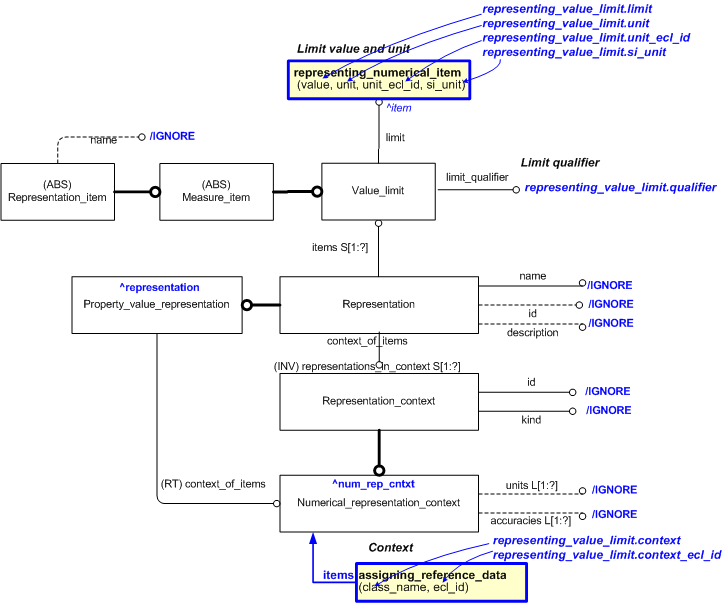

target
is the parameter to which the
Property_value_representation
is bound.
target
is the parameter to which the
Numerical_representation_context
is bound.
| Entity in path | Value | Inherited from |
| Property_value_representation.id | '/IGNORE' | Representation.id |
| Property_value_representation.name | '/IGNORE' | Representation.name |
| Property_value_representation.description | '/IGNORE' | Representation.description |
| Numerical_representation_context.id | '/IGNORE' | Representation_context.id |
| Numerical_representation_context.kind | '/IGNORE' | Representation_context.kind |
| Value_limit.name | '/IGNORE' | Representation_item.name |
| Value_limit.limit_qualifier | @qualifier | — |
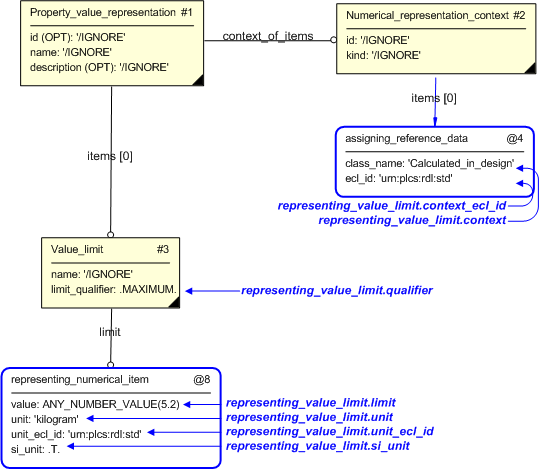
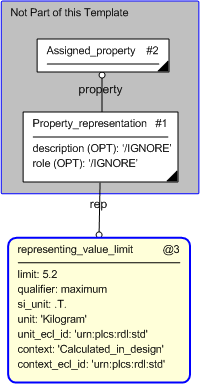
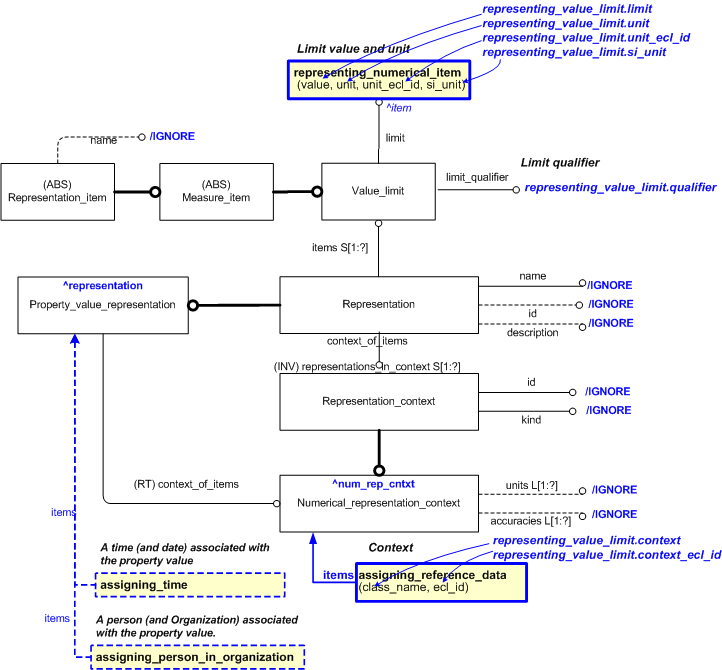
NOTE this characterization is optional.
Time (and dates) can be associated with the assignment of property value representation as in Figure 5. This is described in C079: representing_properties_numerically, template representing_numeric_property. No additional characterization capability is introduced in this template.
NOTE this characterization is optional.
An Organization (or a Person_in_organization) can be associated with the property value representation as in Figure 5. This is described in C079: representing_properties_numerically, template representing_numeric_property. No additional characterization capability is introduced in this template.
This section specifies the template representing_value_range.
NOTE An explanation of a template and the associated instantiation path is provided in the Template overview section.
This template describes how to represent a property value range (with units) for any property.
EXAMPLE The weight of an item may range in weight from 5.05 down to 4.95 kilgrames.
The range (in terms of upper and lower values) of a property value defined in specific units (e.g. time, length etc..) that may be associated with an item.
NOTE The specification and definition of the property and the item to which it is associated, are outside the scope of this template. This template, however, defines the representation andvalues (range of) that may be associated with such a property.
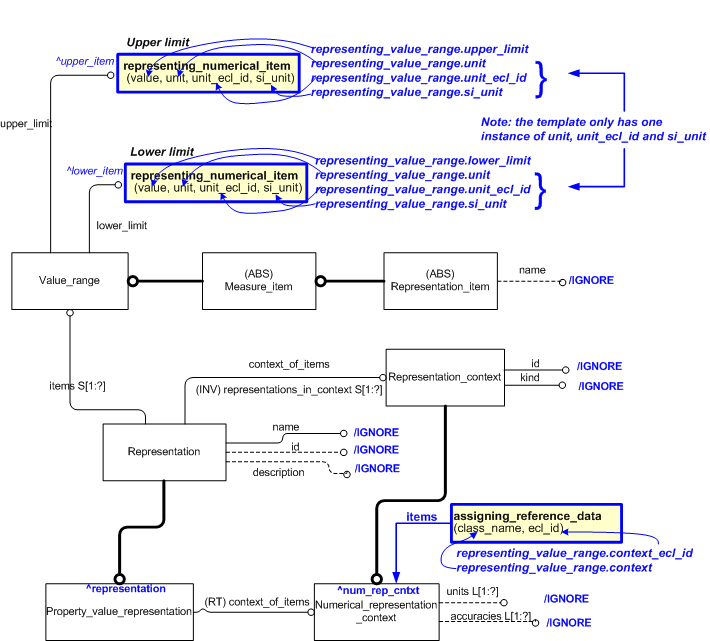

target
is the parameter to which the
Property_value_representation
is bound.
target
is the parameter to which the
Numerical_representation_context
is bound.
target
is the parameter to which the
Numerical_item_with_unit
is bound.
target
is the parameter to which the
Numerical_item_with_unit
is bound.
| Entity in path | Value | Inherited from |
| Property_value_representation.id | '/IGNORE' | Representation.id |
| Property_value_representation.name | '/IGNORE' | Representation.name |
| Property_value_representation.description | '/IGNORE' | Representation.description |
| Numerical_representation_context.id | '/IGNORE' | Representation_context.id |
| Numerical_representation_context.kind | '/IGNORE' | Representation_context.kind |
| Value_range.name | '/IGNORE' | Representation_item.name |
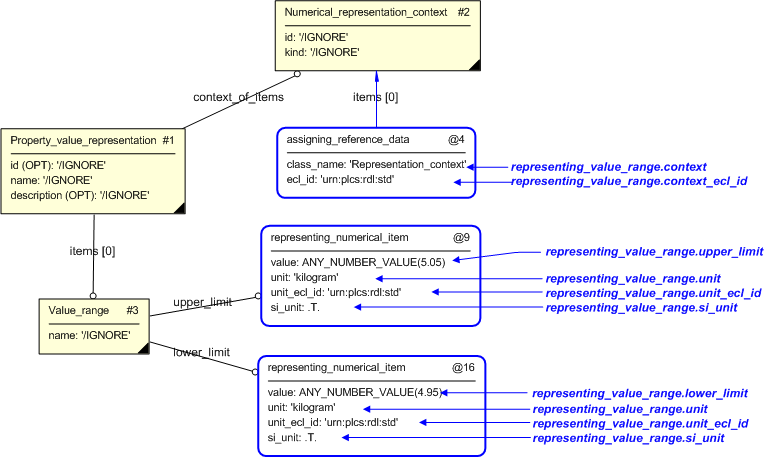
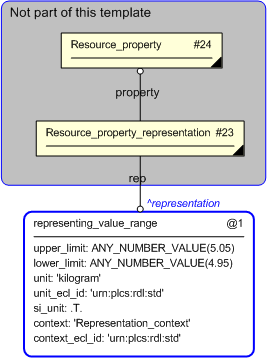
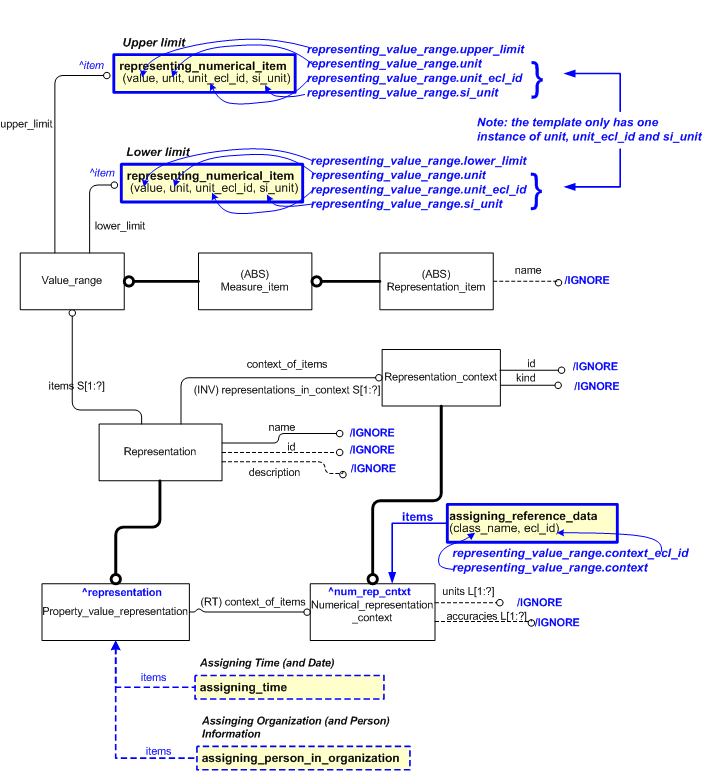
NOTE this characterization is optional.
Time (and dates) can be associated with the assignment of a property value representation as shown in Figure 5, by using the templates assigning_time. An example of this is provided below.
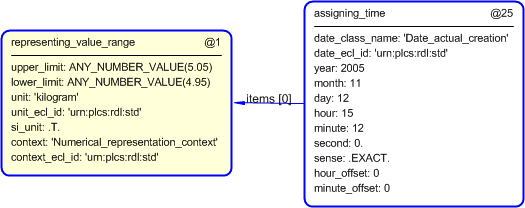
The date of creation of the property value representation is represented by using the template assigning_time to assign a date and time to Property_value_representation (reference parameter ^representation in template representing_value_range). The date and time assignment is classified as: "Date actual creation" (urn:plcs:rdl:std:Date actual creation) to indicate that it is the date (and time) when the property value representation was actually created. This is illustrated in Figure 6.
Other dates may be assigned instead.
NOTE this characterization is optional.
An Organization (or a Person_in_organization) can be associated with the property value representation (see the ^representation reference parameter), as in Figure 5. The creating organization is represented by using the template assigning_organization or assigning_person_in_organization assigned to Property_value_representation (reference parameter ^representation in template representing_value_range). The assignment of the organization (Organization_or_person_in_organization_assignment) is classified as: "Creator of" (urn:plcs:rdl:std:Creator of) to indicate that this organization created the property value representation. This is illustrated in Figure 7.
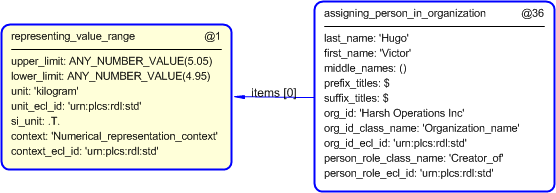
Other roles of an organization with regard to a property value representation may be assigned instead.
This section specifies the template representing_value_w_tolerances.
NOTE An explanation of a template and the associated instantiation path is provided in the Template overview section.
This template describes how to represent tolerances for any associated a property value.
This can be defined as the upper and lower tolerance limits associated with a particular value and unit.
EXAMPLE The design weight (property) of an item is declared as 35 kilograms and the tolerance associated with that value may allow the weight to increase (+) 0.5 kg, (e.g. to 35.5kg) or to decrease (-) 4.0kg, (e.g. to 31kg).
NOTE The upper and lower values are taken to equate to the traditional +/- (plus and minus) engineering tolerance definition that may be associated with a particular value (and unit). Hence the 'lower' limit should always be negative.
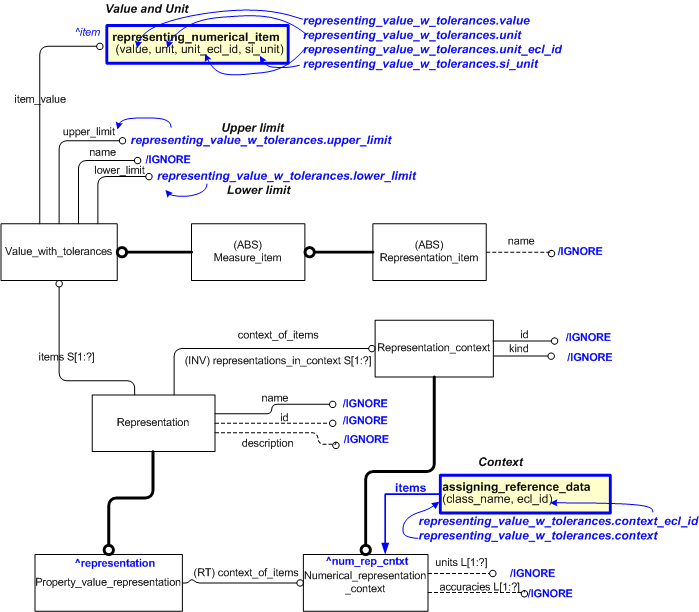

target
is the parameter to which the
Property_value_representation
is bound.
target
is the parameter to which the
Numerical_representation_context
is bound.
| Entity in path | Value | Inherited from |
| Property_value_representation.id | '/IGNORE' | Representation.id |
| Property_value_representation.name | '/IGNORE' | Representation.name |
| Property_value_representation.description | '/IGNORE' | Representation.description |
| Numerical_representation_context.id | '/IGNORE' | Representation_context.id |
| Numerical_representation_context.kind | '/IGNORE' | Representation_context.kind |
| Value_with_tolerances.name | '/IGNORE' | Representation_item.name |
| Value_with_tolerances.upper_limit | @upper_limit | — |
| Value_with_tolerances.lower_limit | @lower_limit | — |
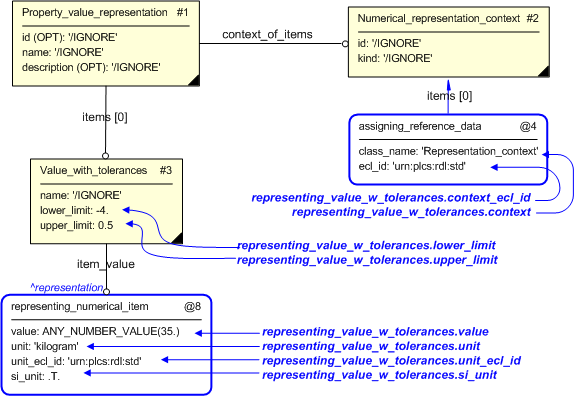
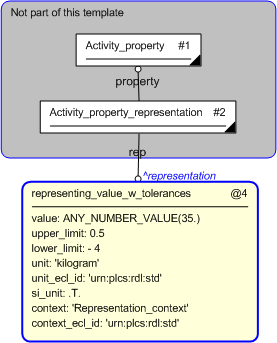
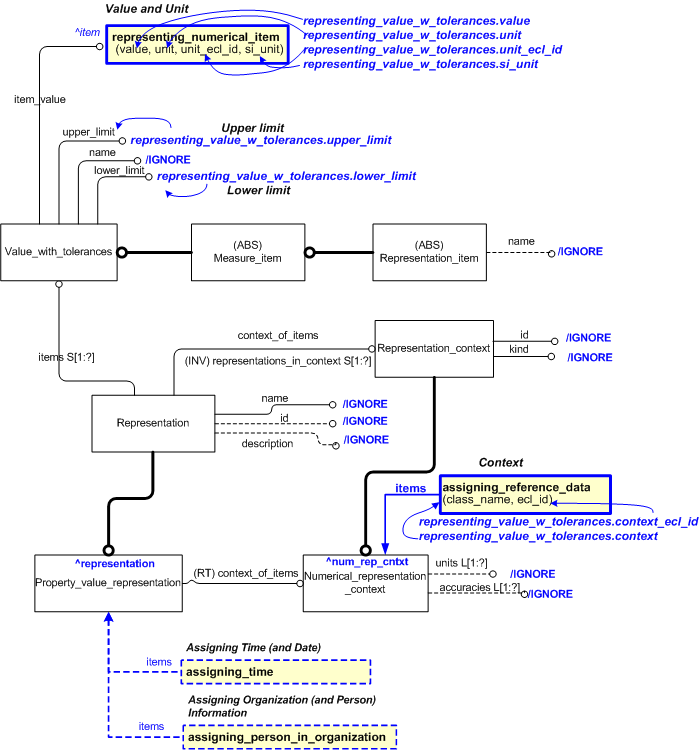
NOTE this characterization is optional.
Time (and dates) can be associated with the assignment of a property value representation as shown in Figure 5, by using the templates assigning_time. An example of this is provided below.
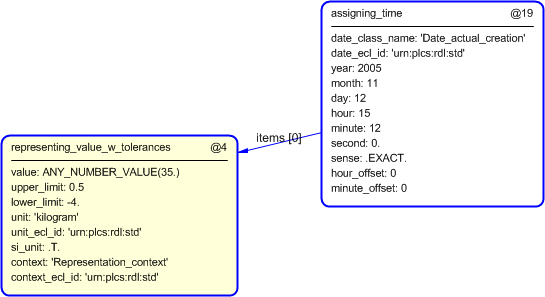
The date of creation of the property value representation is represented by using the template assigning_time to assign a date and time to Property_value_representation (reference parameter ^representation in template representing_value_w_tolerances). The date and time assignment is classified as: "Date actual creation" (urn:plcs:rdl:std:Date actual creation) to indicate that it is the date (and time) when the property value representation was actually created. This is illustrated in Figure 6.
Other dates may be assigned instead.
NOTE this characterization is optional.
An Organization (or a Person_in_organization) can be associated with the property value representation (see the ^representation reference parameter), as in Figure 5. The creating organization is represented by using the template assigning_organization or assigning_person_in_organization assigned to Property_value_representation (reference parameter ^representation in template representing_value_w_tolerances). The assignment of the organization (Organization_or_person_in_organization_assignment) is classified as: "Creator of" (urn:plcs:rdl:std:Creator of) to indicate that this organization created the property value representation. This is illustrated in Figure 7.
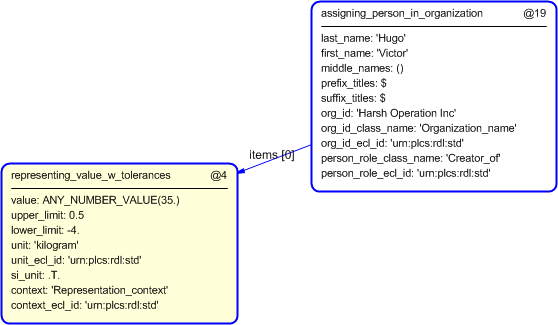
Other roles of an organization with regard to a property value representation may be assigned instead.
This capability "Representing property value ranges" is related to the following capabilities:
This capability "Representing property value ranges" is dependent on the following capabilities:
© OASIS 2010 — All rights reserved